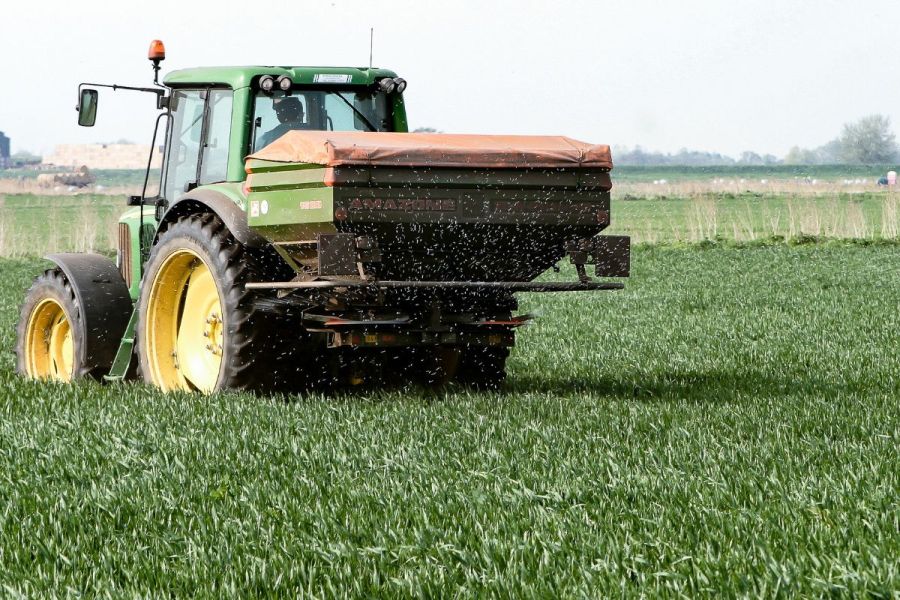Laws to reduce fertiliser inputs have put some German wheat growers at a disadvantage, but recent trials there have shown that managing the soil-borne disease take-all with a seed treatment can help compensate. CPM reports.
“We’ve been able to measure the impact of take-all and its management on nitrogen use efficiency in wheat crops, completely independent of the previous crop.”
By Rob Jones
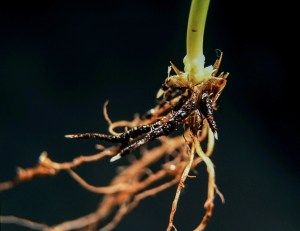
Not all take-all infection is as obvious as in this example. As nitrogen is water soluble and is mostly taken up by the roots in nitrate form, particularly the ultra-fine root hairs covering the roots’ surface, it’s these finer root structures that are most affected by moderate take-all infection.
Like every country across Europe, Germany is tussling with the negative impacts of nitrogen fertiliser pollution and is implementing a national policy that aims to mitigate them.
Whilst these measures are still evolving, the main thrust has seen the designation of ‘red areas’ across the country, where growers must significantly reduce nitrogen fertiliser inputs. This triggered fresh thinking about the role of take-all management as trials have shown that Latitude (silthiofam) seed treatment provides a strong benefit, sometimes regardless of previous crop, which could be attributed to an effect on nitrogen use efficiency.
Germany-based technical specialist Dr Julian Rudelt has had plenty of experience with seed treatments and dissecting their strengths and weaknesses having completed a PhD at Kiel University on the subject.
This work led him into a European arable development management role with Certis Belchim, offering new ideas and technical advice on the company’s seed treatment portfolio, including Latitude.
Germany produces about 25M tonnes of wheat each year, much of it within a banana shaped area that stretches across the north and west side of the country, where adequate rainfall, heavy soils and cooler temperatures support high yields.
The crop is grown in other regions to the east and south which have a drier continental climate, but with lower yields these areas tend to focus on milling wheat production. According to Julian, one of the greatest challenges facing all German wheat growers is the nitrogen restrictions in the red areas, which are impacting on the market growers are producing for.
“Because it’s mandatory to reduce the total applied nitrogen in those areas by 20%, which can be about 50kg/ha, it’s making it very difficult to reach a specific yield and quality in some cases,” explains Julian.
Another trend in Germany, common to many other northern European countries, is the move away from second, consecutive or continuous wheats. This is driven in part by the EU Common Agricultural Policy’s ‘three-crop rule’, which means farms greater than 30ha must grow at least three crops and the main crop cannot cover more than 75% of the area.
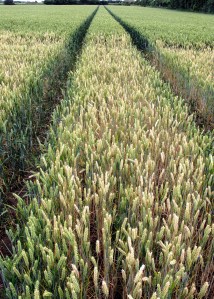
In the east of Germany, the hotter and drier continental conditions makes for a shorter growing season and even when take-all is present in the soil, the classic white head symptoms are rarely seen.
Despite the rule, Julian says there’s still a proportion of second or consecutive wheats grown across Germany and in the north, where a relatively mild and damp maritime climate prevails, crops can be badly affected by take-all.
“We have open autumns and long springs, so conditions are favourable for all types of diseases, including take-all. The slow and steady growing period is the secret to high yields, as plants stay greener for longer, but we often see the white ears and it has a greater impact on yield than in the continental conditions in the east,” he explains.
In those hotter and drier continental conditions, he points out that take-all is very much present in soils, but the shorter growing season and hot spring and summer period means that classic white head symptoms are rarely seen.
“Most growers in the north and west do not doubt the effectiveness of Latitude against take-all when growing wheat after wheat and will almost always use the treatment. However, as it’s a disease that only causes visible effects in single years, it’s not at the front of minds elsewhere, but it is always present and having an impact even where there are no symptoms,” adds Julian.
So, what is the link between nitrogen rules in red areas and take-all pressure across the German wheat area? For Julian, it’s obvious: nitrogen is water soluble and is mostly taken up by the roots in nitrate form, particularly the ultra-fine root hairs covering the roots’ surface. It’s these finer root structures that are most affected by moderate take-all infection that’s not necessarily visible to the naked eye unlike roots blackened by severe infection, he says.
Prompted by the designation of red areas, he set out to measure the impact of take-all on nitrogen use, with the vision that if the disease was better managed, it would be possible to maintain crop performance with less N.
“We’ve been able to measure the impact of take-all and its management on nitrogen use efficiency in wheat crops, completely independent of the previous crop, which is seen as the most important risk factor in wheat,” notes Julian. “The results have been very interesting.”
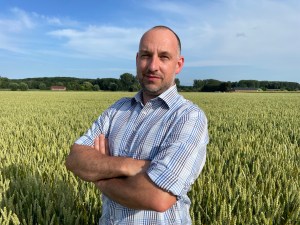
Adam Nears says the work in Germany underlines how important Latitude is in riskier take-all situations, such as second or third wheats, and on soil types conducive to its development.
The dataset that Julian and the team at Certis Belchim has collated is from trials conducted between 2017 and 2021 at four different locations and from wheat plots grown after various crops, including wheat, oilseed rape and sugar beet.
Nitrogen treatments at each site included the maximum N permissible in Germany by law, 20% less N as per red areas, and the third giving the plant only what it required according to NitraCheck tissue testing at key points through the season.
Each nitrogen regime was applied in three splits to plots that had been grown from seed treated with a single purpose seed dressing (SPD) only, or a SPD plus Latitude, which is the only product on the market with take-all control on the label.
Plant sap analysis was also carried out to determine uptake of nitrate and the plots were taken to yield. Results showed that where Latitude was applied to the seed, it protected the wheat seedlings from primary infection in the autumn, which in turn reduced the most damaging secondary root-to-root spread in the spring.
Julian says this promoted a healthier root system with more of the crucial fine root hairs surviving through to spring, enabling treated plots to make more efficient use of resources, reaching higher yields with less applied nitrogen.
“Due to the recent spikes in nitrogen prices, it’s very favourable for farmers to use Latitude and they can earn some additional money with this approach. In the red areas, where farmers have lost the maximum amount of fertiliser they can use, it’s possible to compensate for this loss with the seed treatment as well,” says Julian.
So, is there a change in advice on when and where to use Latitude, and what can UK growers take from the trials?
The same boost to nitrogen use efficiency and yield was seen in the trials when Latitude-treated seed was planted after OSR and nitrogen rates were reduced. Julian says that in Germany this could justify the use of Latitude in a first wheat after OSR, where drilling tends to be in the first half of September increasing the risk of take-all.
Where grassweeds like blackgrass are present in these situations, offering a take-all bridge between cereal crops, that case is even more compelling, he believes.
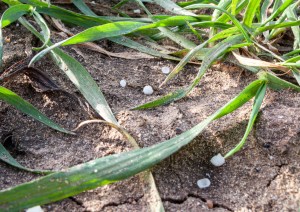
Trials in Germany indicate that where take-all is a risk, Latitude can mitigate the effects especially where N inputs are reduced.
Certis Belchim seed treatment specialist Adam Nears says the work in Germany underlines how important Latitude is in riskier take-all situations, such as second or third wheats, and on soil types conducive to its development.
He adds that the seed treatment should always be used as part of a wider strategy for limiting the impact of take-all, including sowing from mid-October into well drained, consolidated seedbeds.
Choosing varieties with the low take-all build up (LowTAB) trait in the first wheat position and good control of grassweeds and cereal volunteers will also help reduce inoculum load through the crop rotation, he adds.
“Latitude promotes a healthy root system, which is the foundation for efficient use of water, nitrogen and micronutrients, as demonstrated in Germany.
“Our own trials with ADAS in the UK during 2021-22 showed that Latitude significantly improved root health in a high take-all pressure situation and the average yield response across four winter wheat varieties was 1.4t/ha,” says Adam.
With wheat prices back to around £200/t, growers may well be questioning the place of second wheats in the rotation, with growing costs and other risks higher than in many alternative crops.
While the ADAS trial showed an exceptional yield response in a high-risk year, previous long-term UK trials suggest an average yield response to Latitude of 0.55t/ha when used in second wheat, grown under moderate take-all risk.
This dataset provides the basis of Certis Belchim’s online Cost Benefit Calculator tool, which takes expected grain value, seed rate and Latitude treatment cost to give a return on investment in £/ha.
“Even in today’s economics, the calculator shows it will cover treatment cost and add more than £50/ha to gross margin, so it helps reduce some of those additional risks associated with growing second wheat,” adds Adam.
This article was taken from the latest issue of CPM. Read the article in full here.
For more articles like this, subscribe here.
Sign up for Crop Production Magazine’s FREE e-newsletter here.

